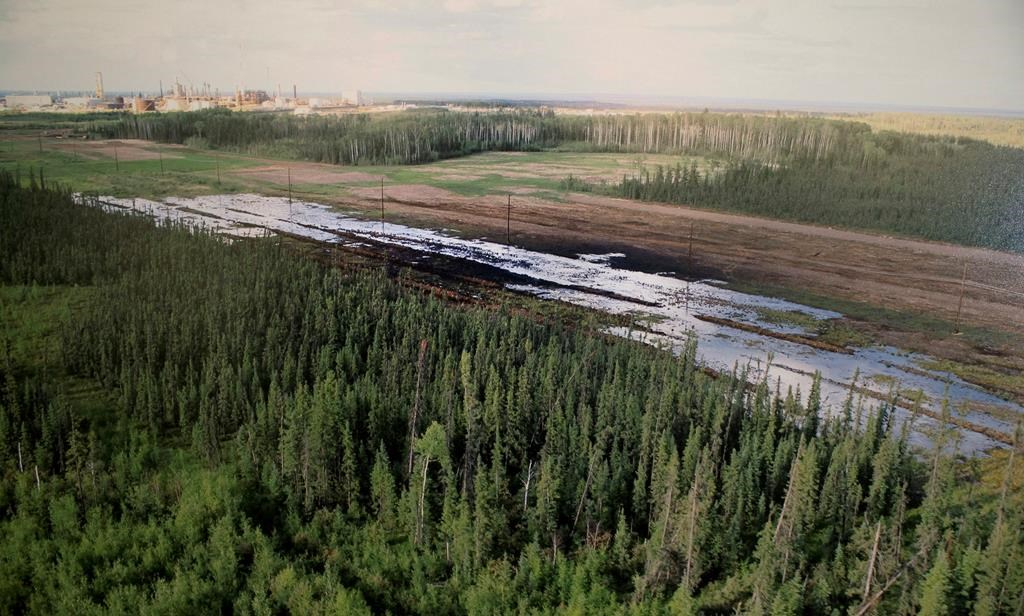Support strong Canadian climate journalism for 2025
A pipeline leak has spilled an estimated 380,000 litres of light petroleum within five kilometres of a provincially designated grizzly bear management zone in northwestern Alberta, and an undetermined amount of it has reached a nearby creek.
Producer ConocoPhillips Canada said in a statement posted on its website Tuesday that the leak of condensate, a liquid produced with natural gas, was seen at a pipeline right-of-way near its Resthaven gas plant about 65 kilometres northeast of Grand Cache last Thursday afternoon.
It said its staff also observed condensate in nearby Webb Creek.
The Alberta Energy Regulator said condensate was visible as a sheen on the surface of the creek for about 4.5 kilometres below the pipeline leak.
The creek flows to a beaver dam and then into the Simonette River. While no sheen was visible on the river, an analysis indicated hydrocarbons present at slightly above minimum detection limits, the provincial agency said.
Meanwhile, the company said the pipeline, which along with the gas plant is jointly owned by ConocoPhillips and Calgary producer Paramount Resources (TSX:POU), has been shut down and isolated and the company has activated its emergency response plan.
"We have deployed over 150 responders to the site with equipment to contain the release and mitigate any environmental impact," the company said, adding that it had reported the leak to the regulator after discovering it last Thursday.
Fencing and amphibian barriers have been erected to keep wildlife away and a wildlife biologist is on site, it said.
Spokeswoman Michelle McCullagh defended the five-day lag between discovering the leak and beginning what it promises will be daily updates on its website.
"Our first priority was making sure there were no residents in the area, notifying the trappers, the First Nations and all the authorities and then, of course, our continued safety for all of our responders on site and then protecting the environment," she said.
No residents were found in the isolated area and the company has seen no evidence of animals or fish hurt by the spill as yet, McCullagh said, adding that the company doesn't know how long it will take to clean up the spill.
The gas plant is still operating, she said.
Mike Hudema of Greenpeace Canada described the number of pipeline spills in Alberta as "alarming."
"While we learn the details of this latest incident we need to ask ourselves how many more spills will it take before we begin to move away from pipelines and make the renewable energy transition other countries are already implementing," he said in a email.
The regulator said in a statement Tuesday that staff members were at the site, which is in the Little Smoky caribou range and near a core grizzly bear management zone.
It said it has issued an environmental protection order to ConocoPhillips directing the company to contain the release and prevent it from spreading, while controlling access, collecting water and soil samples and submitting a final report to the AER.
The regulator said no cause has been established and an investigation is underway.
One of the key uses of condensate is to dilute raw Alberta oilsands crude to allow it to flow in a pipeline to market.





Comments
Why do we want to send bitumen based fuel, through an old west-east pipeline across most of Canada, to be refined in St. John, New Brunswick or shipped from St. John, New Brunswick? The recent pipeline break in northern Alberta has taken Conoco Phillips 5 days to respond to. I recall working as a surveyor's helper north of Earlton Ontario in the 1950's; surveying the route of a pipeline through north eastern Ontario. That pipeline now should be some 55 years old and Alberta wants to send 1.1 million barrels of oil sands per day through this old pipeline. Disasters waiting to happen. Let's leave the oil sands the ground and move to renewable energy.